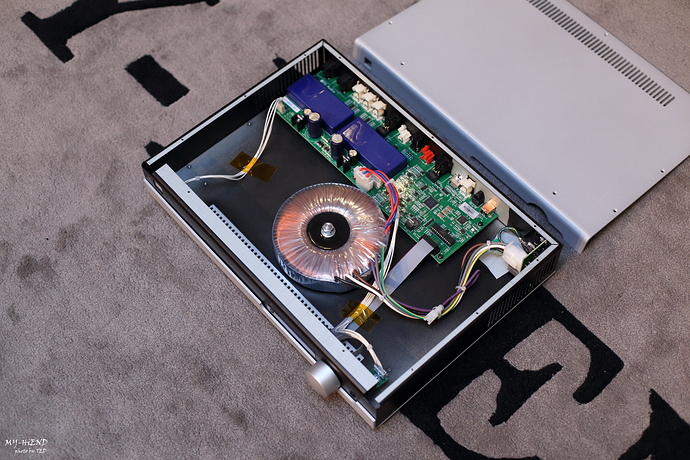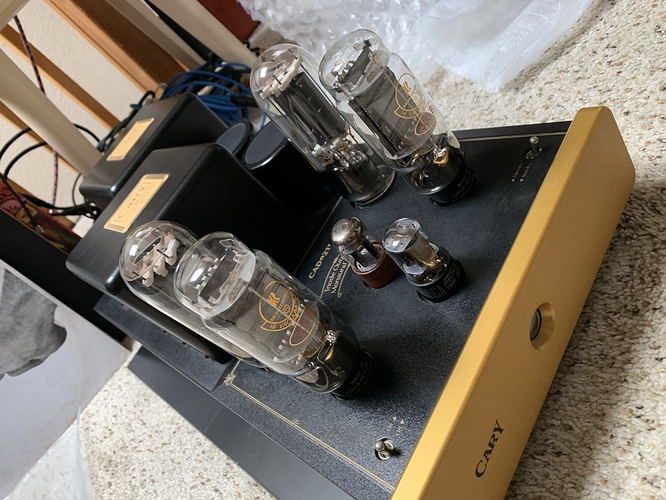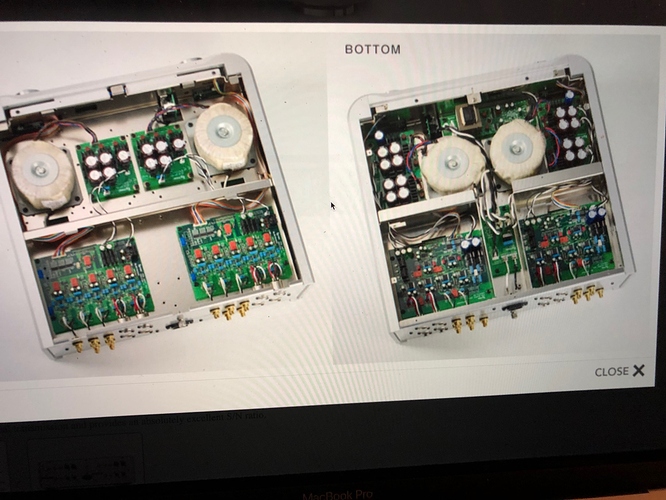Silly semi-noob post. Just ordered a Stellar GCD and am exited to get it (running Emotiva XPA-100 mono-blocks to, when I get them, Maggie LRS’s), and I came across this pic of an opened Stellar GCD. Seems a bit…empty in there…
I have no idea what my point really is here, but it felt odd seeing so much empty space in a $1600 unit. I worry too much…
I continue to be surprised how much empty space there is in a standard size piece of audio equipment. Even when the unit contains large tubes there remains a good amount of empty space.
I assume the designers take advantage of the space to keep noisy components away from sensitive ones.
Everything could be packed into a smaller package, but it would feel odd to get a half-space unit in consumer audio.
Thanks for the picture. I always enjoy seeing the innards.
Isn’t the ‘standard’ size based on what we’ve grown accustomed to for shelves and other suitable locations to set and stack the gear?
Space between parts is good as most of the radiation will follow a logarithmic drop off. 2x distance drops noise 8x and so on (for example, I have little idea how quickly it drops off but I know it’s rather quick)
I’d much rather have a mostly empty package than one stuffed to the literal gills like most HT AV units.
…and they sit better on the shelf
That depends on what you buy. Some boxes are full of air. Some are so full they need to put power supplies in a separate box. Horses for courses.
Yep.
Power supplies are placed in separate boxes as a means to minimize noise.
“More is better” when it comes to stuff crammed into a case, is not an absolute.
I had a conversation with a very well known dealer who sells a lot online, during which he told me that a FirstWatt amp was not very good because there’s not much in the box.
I thought that he was missing the point.
I had the same thought as in the UK there is no such thing as a standard box size and many are much smaller than the typical USA 440mm or whatever it is. It is very simple, we live in smaller homes.
If you think of the amount of technology packed into a mobile phone, it can be done with audio, as Devialet did with Expert 10 years ago, and there is no need for a separate box for the power supply.
In those discussions it’s always a chance to point out how little the number of components in a unit seem to have to do with its sound.
This is a Preamp I’ve heard and it’s one of the best and especially most transparent sounding imo (just as its interior is looking  ) My current one rather looks like the opposite and sounds fantastic, too…so I wouldn’t bother too much about that…but I understand, that the thought of “parts for the money” can arise.
) My current one rather looks like the opposite and sounds fantastic, too…so I wouldn’t bother too much about that…but I understand, that the thought of “parts for the money” can arise.
When I looked at the GCD picture the big transformer was most obvious for me…just like in some Naim equipment with focus on power supplies. A good sign usually.
I was equally surprised when I opened my new new Steller Gain Cell DAC voluntarily to try improved firmware that was programmed on a chip I had to exchange.
The audio board seems as crammed as the audio board in my AV receiver.
But it’s truly different in important ways. The toroidal transformer and power supply do seriously benefit the sound quality, the DAC sounds really good and accepts close to any realistically useable sound format including DSD.
The volume control concept is original and defeats all disadvantages of resistor, potentiometer based volume controls. It is fully balanced.
However it comes with quirks, which is why I opened that brand new unit to try and resolve those by means of trying a firmware update. I fully agree however, they have so much space, the SGCD costs very serious money. So, why on earth did they cram everything on a tiny PCB? Wider low impedance traces, larger distances between traces in some of the analog sections would have improved sound quality and input / channel separation so much or even have avoided some of the quirks the unit has.
It can go either way - more space for separation can be good, but the longer the wires/traces that audio go thru the worse (in general.)
I always appreciate your efforts in guarding against generalizations.
Very refreshing…
FWIW/Cheers.
SEE
Recently got this ARC Ref 75SE from the Music Room. It has a lot of space in it as well, primarily to accommodate the height of the tubes and give them room to breathe. If they had oriented the tubes horizontally I would imagine they could’ve taken a rackspace off the overall height of the unit:
This monoblock Cary has no top to take off:
Other than this sort of thing, and the devices noted above, stuff is generally getting way smaller, to take Class D amps as an example. The performance of some of these Cavernous boxes, particularly for the price, makes me unconcerned about how full a given chassis is. Fun Times!
I agree with that sentiment, and I’m not complaining at all. The Stellar GCD has an excellent rep and I’m sure will sound great. It’s just surprising, esp from a non-engineering type like myself, to see the inside and think “where’s the beef”? (See what I did there?..)
And as Jazznut stated, it’s hard for some to wonder about the “parts for the money” thing too. I remember building some heathkit stuff that looked very similar to the SGCD (well, not the transformer or GC circuit). Anyhoo, just interesting to me.
I think we look at these higher end units and just assume that PACKED inside those boxes there is all sorts of NASA-eque wizardry going on…
Good one…where’s Clara Peller when we need her? ; )
I think it has more to do both with components getting smaller, and with the fact that, at least in the US, the single-rackspace chassis is a standard and expected box. Not to mention available in many forms and materials from many makers for reasonable money. Yeah - you could put a lot of current devices in smaller boxes, but likely people would wonder where the Box Beef was, so to speak, or complain that it did not fit in with the aesthetic of their other boxes.
Bear in mind that many of these boards are fully analog devices, as were their large, inefficient, heat and power-wasting progenitors - leaving price and perceived/preferred audio quality out of it for the moment.
Re: your last sentence, one of the very things that boggles my mind about some of these boards is exactly that - the NASA-esque wizardry. Exactly what one would be compelled to do to make the performance, weight and efficiency optimal for launching into space.
Having said all that, comparing these devices with ones that cost many multiples more, are performing multiple different functions, and/or are entirely different topologies…
Yup, and maybe there is some realizing that we are expecting DARPA-esgue stuff, when in reality it is more conventional, realistic, but advanced, NASA-esque. Which is awesome.
Not to make this into any sort of lovefest, bruh, but your handle subconsciously influenced me to spin some Jimi:
“Stone free do what I please
Stone free to ride the breeze
Stone free I can’t stay
I got to got to got to get away…”
That’s where I got it! The Clapton cover is also awesome.
Was inside the power supply section of my Cary SLP-05 today replacing the power supply tube. Snapped a picture thinking of this thread. Plenty of extra space.






